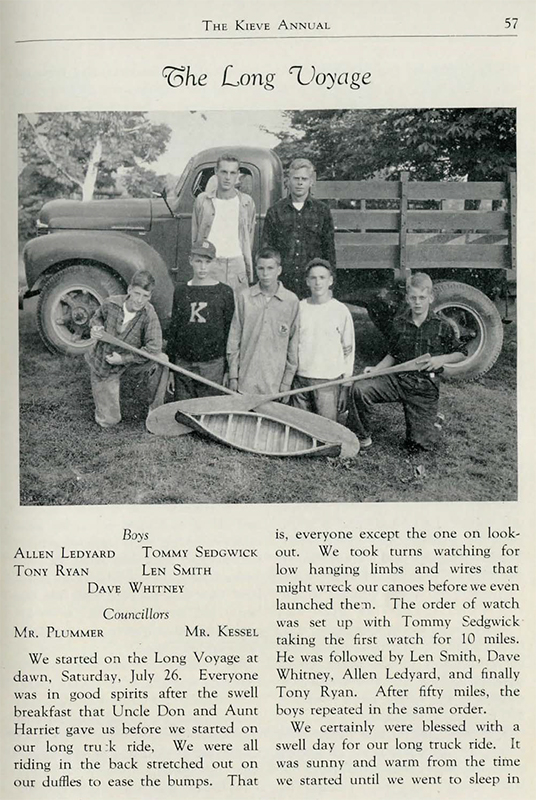A Long Voyage Memory Tony Ryan, Kieve ’47, ‘48
I have a quibble with the identification of the photo on page 10 of the recent issue of K-W News. I attended Kieve in the years 1946 and 1947 and remember that at the time there were two series of overnight canoe trips during each camp summer. The first were more or less introductory trips while the second tended to be the “real stuff.” Of these, the most demanding was a canoe trip in Canada populated by the camp’s older boys. This was called something like the “The Wilderness Cruise” trip and I think Hudson’s Bay may have been on the itinerary. Ranking second in duration was the Long Voyage. I remember seeing photos of the Wilderness Trippers at the time and being envious that they, unlike all the campers on the other excursions, wore woodsmen’s clothing rather than the then current daily camp wear as shown in the b/w photo on the following page. I think the photo on page 10 is not of Long Voyageurs, but participants in the Canadian trip.
For several reasons, age being one, I never got to go on the Wilderness trip, but did do the Long Voyage twice. I’m fairly certain that the ’47 trip was the first time Kieve had elected to use that particular route. We put in at Caucomgomoc Landing, went down that stream of the same name to Chesuncook Lake, then up the West Branch and took out at Northeast Carry. While on Caucomgomoc Lake we diverted to Round Pond for a few days where we fished, hiked up Allagash Mountain and followed the old carry to Allagash Lake.
As I recall we had four canoes, each with two occupants including two counselors. Being the youngest of the collection, that first year I paddled in the bow of senior counselor and trip leader, Larry Plummer. Clearly older than the average counselor—probably, what?, in his 40s (wow!)—I was appropriately impressed by Larry. Back at camp he ran the waterfront in a no nonsense manner and taught us Junior Lifesaving among other skills. A Maine native, he held a Guide’s License and to me it seemed there was little he didn’t know about camping in the Maine woods, but there were a few times his then unfamiliar accent left me scratching my head.
As was the custom in those earlier less paranoid days, we rode all day from Kieve to Caucomgomoc in the back of an open truck (!) and had camped that first night at the landing. Our first real camp was the next day at Round Pond where the two counselors set about instructing us on setting up camp. Larry kept mentioning something about putting up a “tap.” Now tents I knew and wanigans had been easy enough to figure out, but this “tap” eluded me even after we had erected a canvas fly over the kitchen area. Of course, the “tap” referred to the tarpaulin or tarp which constituted the fly, but it took me longer than I like to admit to parse that one out.
Leaving Round Pond we’d camped at Caucomgomoc dam prior to starting down that stream the next day. Just below the dam is a rocky stretch known as the Horse Race or, more properly, the Hoss Race. In those long ago days the dam was built of logs and, in keeping with a requirement that the stream flow be kept adequate for navigation, the paper company installed a dam tender whose duty was to open a sluice gate on request to allow enough water for said navigation. That evening Larry had gone to make the arrangements for the necessary water and had returned with some long, slender, freshly cut spruce poles, one for each of our canoes. I don’t remember or perhaps never knew if the use of poles when descending through whitewater was something Larry already was aware of or if it was something he picked up from the dam tender. I suspect the latter, as poles had not been mentioned before. At any rate, we all broke out knives and set to peeling the bark from the poles and properly smoothing them.
In later years I learned of the great skill required to snub a canoe down whitewater with a pole and, at that, one properly shod with an iron tip. The expectation that any of our crew could have pulled that maneuver off successfully was a pipe dream. Other than the exhilaration, there are several vignettes I recall from that run. Riding in the bow of Larry’s canoe I remember “haystacks” of whitewater higher than my head, I remember at least one of the canoes which had preceded ours capsized. And to this day I can see Larry’s freshly peeled spruce pole, now jettisoned, sailing through the air like a javelin as he quickly reverted to the paddle. Larry wasn’t one partial to expletives, but I’ll bet if it hadn’t been for the roar of the Hoss Race I’d have heard a few of those sail along with the pole.
The next year The Long Voyage used the same route, but for some reason that time around we reversed direction.
I regret that over the years I lost contact with Kieve and even more so that I didn’t maintain contact with Larry Plummer who embodied so many of the happy memories I have kept of my two years at Kieve. Larry continued his association with Kieve until 1954 and he passed away in 2001.
* * * * * * * * *

